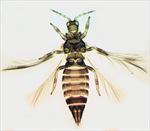
Neohydatothrips samayunkur female

Antenna
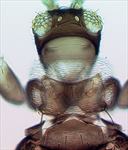
Head & pronotum
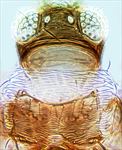
Neohydatothrips samayunkur head & pronotum
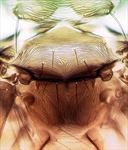
Mesonotum & metanotum

Thoracic sternites
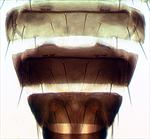
Abdominal tergites VI–VIII

Abdominal sternites

Second instar larva

Fore wing
Both sexes fully winged. Body bicolored, mainly dark brown with abdominal segments III–VI yellowish with brown antecostal ridge; pronotum yellow at anterior margin, also all tarsi, base and apex of tibiae, and base antennal segments II–V; fore wings pale with two transverse dark areas, small dark area at base. Antennae 8-segmented, III & IV each with short forked sense cone. Head with three pairs of ocellar setae, pair III on anterior margins of triangle; postocular region short. Pronotum anterior half with transversely elongate reticles, "blotch" darker with closely spaced striae; posteroangular setae 65 microns. Metanotal striations transverse at anterior, closely longitudinal medially. Fore wing with first vein setal row complete Abdominal tergites II–V median setae often with distance between their bases scarcely twice diameter of setal pore; VII–VIII with posteromarginal comb of microtrichia complete. Sternites with many microtrichia medially as well as laterally.
This introduced, strikingly bicolored pest of Marigold plants is similar to N. burungae and N. variabilis in having microtrichia across the median area of the abdominal sternites. It differs from variabilis in having brown markings on the hind tibiae, and in tergites IX–X being as dark brown as VII–VIII. Unfortunately, samayunkur was misidentified by Mound & Marullo (1996) as a species known only from Mexico, Neohydatothrips pseudoannulipes Johansen, this error being recognized subsequently by Nakahara (1999). The genus Neohydatothrips is found in many parts of the world and almost 120 species are listed. Identification keys are available to 13 species recorded from Central America (Mound & Marullo, 1996), and 41 species from the Neotropics (Lima & Mound, 2016). Stannard (1968) treats 11 species from Illinois, but many of the 35 species described from the USA north of Mexico (Nakahara, 1988) remain poorly defined.
Breeding in flowers and on leaves and sometimes causing leaf deformation on cultivated Tagetes erecta (African marigolds) [Asteraceae].
Recorded from USA (Florida, California, Hawaii), Mexico, El Salvador, Costa Rica, Japan, Australia, Sri Lanka, and Kenya.
THRIPIDAE - SERICOTHRIPINAE
Neohydatothrips samayunkur (Kudo)
Hydatothrips (Neohydatothrips) samayunkur Kudo, 1996: 169
Neohydatothrips pseudoannulipes - misidentification in Mound & Marullo, 1996; NOT pseudoannulipes Johansen, 1983
Lima EFB & Mound LA (2016b) Species-richness in Neotropical Sericothripinae (Thysanoptera: Thripidae). Zootaxa 4162: 1–45.
Mound LA & Marullo R (1996) The Thrips of Central and South America: An Introduction. Memoirs on Entomology, International 6: 1–488.
Nakahara S (1988) Generic assignments of North American species currently assigned to the genus Sericothrips Haliday (Thysanoptera: Thripidae). Proceedings of the Entomological Society of Washington 90: 480–483.
Nakahara S (1999) Validation of Neohydatothrips samayunkur (Kudo) (Thysanoptera: Thripidae) for a thrips damaging Marigolds (Tagetes spp.). Proceeedings of the Entomological Society of Washington 101: 458–459.
Stannard LJ (1968) The Thrips, or Thysanoptera, of Illinois. Bulletin of the Illinois Natural History Survey 29: 213–552.